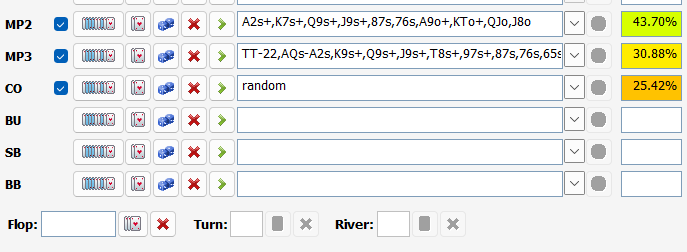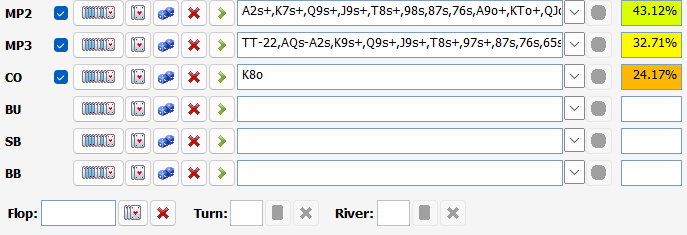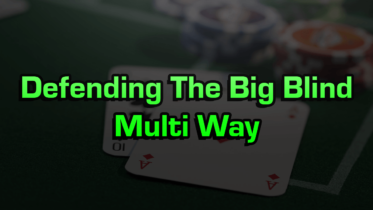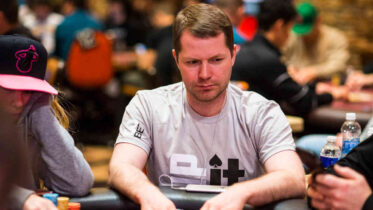One of the biggest mistakes that I see in weak players is that they defend their big blind too wide in multi-way pots. In today’s article, I want to discuss adjustments that need to be made when calling in the big blind multi-way.
Poker is a game that is constantly evolving, 5-6 years ago everyone vastly overfolded their big blinds getting too good of a price preflop and giving up too much expected value (EV). In the last 2-3 years, players have caught onto this trend and know they probably over defend their big blind (BB) with too weak of hands. They have over adjusted in my opinion. The specific situation we will cover today is the biggest errors they can make though. In today’s example, we will discuss a simple situation where middle position raises to 2.5bb, the button calls and we are in the big blind. We will assume we are 100bb deep in all situations.
Making Multi-Way Pots Simpler
Before we get into the nitty gritty, let’s talk about a simpler situation. Let’s assume the middle position player raised and no one called and we are now closing the action in a heads-up pot in the BB. We will use a very powerful tool, Power Equilab, to help us analyze the situation. Some basic math first to calculate our pot odds. We are facing a 2.5bb raise from the lojack (LJ). There is 2.5bb + 1.5bb in the pot from blinds and antes and we must call 1.5bb more. Therefore, we must risk 1.5bb to win 4bb + our 1.5bb which means we need 27% equity. We should call with all hands with more than 27% equity vs the MP opening range after taking into account equity realization.
In this simple example, we will look at K-8 offsuit. Below you will see the MP range that I assigned and the equity that K-8 offsuit has against that range.


As you can see, with 37% equity we have a clear call with K-8 offsuit. We have to realize at least 70% of our equity post flop to make this a reasonable defend. K-8 offsuit doesn’t have the best playability, but we should be able to realize enough equity. If you look at any GTO chart, K-8 offsuit is a clear call here.
Now that we have explored this simpler example facing a heads-up situation, what happens when the button flat calls and now we have the same decision with K- 8 offsuit. First, lets recalculate our pot odds. We have to call 1.5bb to win 1.5+2.5+2.5+1.5 = 8. We are getting better pot odds and now need roughly 19% equity to justify a preflop call. In the above heads-up situation we required 27%. For reference, 7-2 offsuit has 27% equity versus the MP open in a heads-up pot.
For this example, we will give the button the following cold calling range and leave the MP range untouched.

Below, you can see that a random hand in this situation has around 25% equity to call with our better pot odds, more than enough to call preflop you would think.

Here you can see that K-8 offsuit only does slightly worse than a random hand, this is because K-8 is now heavily dominated since two possible ranges can contain a hand that dominates us.

These calculations don’t take into account reverse implied odds or equity realization. If you were to use a solver tool, you would find that the EV of K-8 offsuit is drastically lower than its equity/pot share because of very poor equity realization.
Comparing Multi-Way Pots To Heads-Up Situations
In the heads-up situation, we can easily call with K-8 because we will realize enough of our equity. While the in-position player will out play us and steal EV from us by making better informed decisions, we still realize enough equity to justify our preflop call. However, playing multiway, we realize even less equity than the heads-up situation, as in a heads-up pot, you can often win at showdown with one pair or a strong high card hand like -ace-high. When multiway, however, the threshold of hands required to win at showdown is higher. You need stronger pairs or perhaps two pair to win at showdown because there are more players in the pot. K-8 offsuit is a very poor hand to try to make better than one pair. We cannot make a two card flush or two card straight. K-8 offsuit does fine in a heads-up spot because of the pairs it can make, but struggles in a multiway spot.
We should choose to fold hands like K-8 offsuit and A-8 offsuit, while defending with hands like 6-5 offsuit, 6-4 offsuit and various suited combos that have a better chance to make better than one pair and can realize their equity better. This is a very important concept that is misunderstood by players. Most players defend wider when more players are in the pot due to pot odds, where they should really be defending tighter or at least be more selective in the types of hands they defend.
In conclusion, be very careful defending multiway with weak holdings that can only make weak paired hands. You want to defend multiway with hands that have better chances of making a hand greater than one pair. These hands will have higher EV in a multiway pot.
Best of luck at the table
Matt




